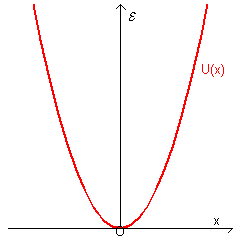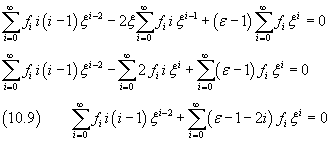
From (2.13), the graph of the potential energy of a one-dimensional harmonic oscillator with respect to the distance x from its equilibrium position, is a parabola with vertex at the origin O and up concave.

A particle with finite total energy
![]() that moves with harmonic motion is contained into a infinitely deep potential well so the probability to find it
at infinite distance is zero.
that moves with harmonic motion is contained into a infinitely deep potential well so the probability to find it
at infinite distance is zero.
In this case the Schrödinger equation is
![]()
and, taking U(x) from (2.13),

![]()
This last equation can be simplified by the variable subtitution
![]()
from which

so, from (10.2) we have


We can have a more simple notation of (10.2) if we let
![]()
so
![]()
The solution of this equation must approach 0 as ξ approaches positive or negative infinity: we may express it as
![]()
where φ(ξ) is a function to be determined later.
By substituting this expression and its second derivative with respect to ξ in (10.5) we have

![]()
Now we assume that the solution φ of (10.7) may be expressed by a series expansion
![]()
and therefore

By substituting these values in (10.7) we have

Since φ does not have singularities, we cannot consider negative exponents, so

The sum (10.10) is identically zero if and only if all its coefficients are zero

The equation (10.11) establishes a recursive relationship between the coefficients of the series expansion(10.8) of φ(ξ)
Moreover, since φ(ξ) must be finite for any ξ, there must be an index n of the expansion such that the not-zero n-th term would produce the (n+2)-th term equal to 0 an so all the following terms with indexes (n+4), (n+6) and so on. Therefore, from (10.11) we obtain
![]()
that is, from (10.4)

If we use the Planck constant instead of the Dirac constant we have

The equation (10.14) represents a fundamental result in the history of Physics of the twentieth century, because it provides a theoretical justification to the Planck conjecture and improves it: harmonic oscillators, contrary to that provided by Classical Mechanics, may not have any energy, but their energy is quantized. The minimum value of the energy of a quantum oscillator id given by (10.14) with n=0. All other possible energy values differ from that for multiples of hν. So a harmonic oscillator can emit or absorb energy only if it exchanges with the outside blocks of energy multiples of hν.